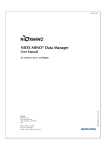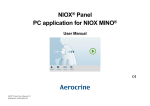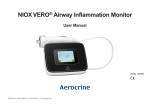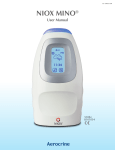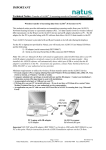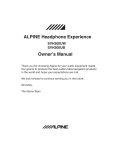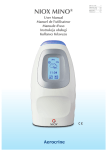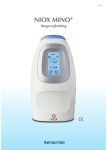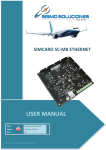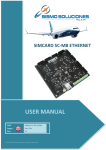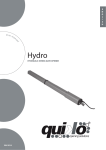Download NIOX Patient User Manual US.book
Transcript
NIOX® Patient User Manual NIOX® Patient User Manual US 000818-02 (EPM-000225) Table of contents 1 Important information .................................................................3 5 NIOX® Admin ............................................................................ 17 1.1 Before using NIOX® Patient ....................................................... 1.2 About this manual ..................................................................... 1.3 Compliance............................................................................... 1.4 Responsible manufacturer and contacts .................................... 1.5 Warnings................................................................................... 1.6 Intended use ............................................................................. 5.1 Start NIOX® Admin.................................................................. 5.2 NIOX® Users ........................................................................... 5.3 Create new user ...................................................................... 5.4 Customize patient Journals...................................................... 5.5 Physicians ............................................................................... 5.6 Database & Setup ................................................................... 5.7 QC Users ................................................................................ 3 3 3 3 3 4 2 Product description .....................................................................4 2.1 NIOX® Patient ............................................................................ 4 3 Installation and setup ...................................................................5 3.1 PC requirements........................................................................ 3.2 Installation................................................................................. 3.3 Database setup ......................................................................... 3.4 Server requirements................................................................... 3.5 Set NIOX administrator privileges the first time .......................... 3.6 Installation of NIOX Database on SQL server............................. 5 5 7 7 8 9 18 18 19 20 22 22 24 6 NIOX® QC ................................................................................ 24 6.1 Start NIOX® QC....................................................................... 25 6.2 View instrument QC status...................................................... 25 6.3 View instrument QC logs ........................................................ 25 4 NIOX® Patient .............................................................................9 4.1 Start NIOX® Patient.................................................................... 9 4.2 Create new patient .................................................................. 11 4.3 Search for a patient ................................................................. 11 4.4 Open a patient Journal ............................................................ 12 4.5 Make changes to an opened patient record............................. 13 4.6 Patient Notes........................................................................... 14 4.7 Manage measurements............................................................ 15 4.8 Create a report of a Journal ..................................................... 16 4.9 Automatic import of measurements from NIOX® Panel............. 17 NIOX® Patient User Manual US 000818-02 1 Chapter 1 Important information 1 Important information 1.1 Before using NIOX® Patient NIOX® Patient should only be operated as directed in this manual by trained healthcare professionals. Trained status is achieved only after careful reading of this manual. Read the entire instructions for use and make certain that you fully understand the safety information. NIOX MINO® User Manual or NIOX VERO® User Manual respectively applies for how to use the different devices. Symbol Description WARNING! Indicates a potentially hazardous situation that, if not avoided, can result in bodily harm or injury. CAUTION! Indicates a potentially hazardous situation that, if not avoided, can damage a product or system, cause loss of data or harm to business. Note Alerts the reader to important information on the proper use of the product, user expectations, error situations, and actions related to these. 1.2 About this manual NIOX® Patient User Manual - English US 000818 (EPM -000225), version 02, May 2015. The User Manual provides instructions on how to operate NIOX® Patient. It contains numbered step-by-step instructions with screens and illustrations. Buttons are illustrated in bold or as icons. Choices within steps are displayed with bullet points. 1.3 Compliance NIOX Patient is CE marked according to In Vitro Diagnostics Directive 98/79/EC. 1.4 Responsible manufacturer and contacts Aerocrine AB Råsundavägen 18, 169 67 Solna, Sweden Aerocrine AB, P.O. Box 1024, SE-171 21 Solna, Sweden www.aerocrine.com www.niox.com 1.5 Warnings • NIOX® Patient should only be operated by healthcare professionals. • Operate NIOX® Patient as stated in this manual. Aerocrine accepts no responsibility for damaged application or faulty results, if the application is not handled according to this manual. Information in this document is subject to change. Amendments will be made by Aerocrine as they occur. • Modification of NIOX® Patient application is not allowed. Aerocrine, NIOX, NIOX MINO and NIOX VERO are registered trademarks of Aerocrine AB. • All warnings in the NIOX MINO User Manual are also applicable when NIOX MINO® is used together with NIOX® Patient. 000818-02 NIOX® Patient User Manual US • Do not use a damaged application. 3 Chapter 2 Product description • All warnings in the NIOX VERO User Manual are also applicable when NIOX VERO® is used together with NIOX® Patient. 2 1.6 2.1 Intended use NIOX® Patient is a PC application designed to store, display and report a patient’s FeNO measurements obtained from any NIOX® instrument. As NIOX® Patient is preferably used in conjunction with NIOX® Panel and NIOX® instruments, it is recommended to read their corresponding user manuals in conjunction with the use of NIOX® Patient. NIOX® Patient can store data either locally or in a network database. 4 Product description NIOX® Patient NIOX® Patient is designed to manage patient records, measurements, reports and database administration. The software contains an administrative mode to manage user information, customize patient records and reports. The database allows measurements pertaining to a specific patient to be centrally collected even if they are performed on several different instruments. 2.1.1 NIOX® Panel NIOX Panel is described in the NIOX VERO User Manual and a separate user manual for NIOX MINO. NIOX Panel is a visual aid that allows the user to operate the instrument from a PC and store measurements in the database. 000818-02 NIOX® Patient User Manual US Chapter 3 Installation and setup 3 3.1 Installation and setup 2. An installation wizard opens, accept license agreement. PC requirements Operating systems • Windows® 7 (32 or 64 bit) • Windows® 8.1 Pro (32 or 64 bit) Supported screen resolutions • 1024x768 • 1366x768 • 1280x800 • 1920x1080 3.2 3. To create a standard installation select “install” and continue with step 7. To change installation path or add more features than predefined select “advanced”. Installation 1. Select the file setup.exe in the installation folder. 000818-02 NIOX® Patient User Manual US 5 Chapter 3 Installation and setup 4. Recommended is to install for “all users of this machine” 6. Select what features to be installed, and then click “install”. 5. To edit installation path select “Change”. 7. Wait for the programs to be installed. 8. The programs are now available in the selected location or in the start menu. 6 000818-02 NIOX® Patient User Manual US Chapter 3 Installation and setup 3.3 Database setup NIOX Patient is connected to a SQL CE database by default. 4. Enter the name of the database. 5. Select Authentication Method: Windows Authentication (continue with step 7) or SQL Server Authentication. 6. Enter SQL Server user name and password. Note: Print and save the credentials in a secure place. 7. Select Test connection. 8. If the test is successful, select Save connection. 3.4 3.3.1 SQL CE Single user database setup 1. Start the Database (Db) program from the start menu. 2. Select SQL CE (local database) 3. Select Test connection. 4. Select Save connection. 5. NIOX Patient is now connected to the local database installed on the computer. 3.3.2 Note: SQL Multiuser Database setup Before NIOX Patient can be connected to a multiuser Database, the database has to be created. For instructions “Installation of NIOX Database on SQL server” on page 9 1. Start the Database (Db) program from the start menu. 2. Select Use SQL Server. Server requirements Server requirements • Microsoft® SQL Sever 2008r2 3.4.1 Server installation and configuration 3.4.2 Network requirements To be able to connect to the multiuser database, a network connection between the computer and the network database is needed. Contact your network administrator. 3.4.3 Import database from DataManagement Program It is possible to import a database from NIOX MINO DataManagement Program (version 2.1.0.1 or 2.2.0.0) to an empty single-user database. For instructions on how to create a backup from Data Management Program refer to the Data Management Program User Manual. 3. Enter the address of the SQL Server (computer name/database instance name). 000818-02 NIOX® Patient User Manual US 7 Chapter 3 Installation and setup Start Admin, select Database & Setup. If the database is empty select “Restore DM Database”. Select the backup-file to import the database. When restoration of the database is complete the button changes to “Backup database”. For network database, contact the network administrator. Aerocrine recommends creating a new single user database, importing as described above, exporting SQL CE definitions and data to a SQL script, and running the script on the SQL Server. 3.5 Set NIOX administrator privileges the first time The system comes with a default administrator account in NIOX Admin. 1. Select the “Ad”-icon on the start menu. This opens the NIOX Admin application. 2. Select NIOX User. This opens the NIOX User view. 3. Log in as: User name: a Password: p 8 000818-02 NIOX® Patient User Manual US Chapter 4 NIOX® Patient 4. Select the user from the list and set a new user name (optional) and a new password (recommended). Refer to “Edit user” on page 19. 4 5. Print and save the new administrator credentials in a secure place. NIOX® Patient is used to administrate information regarding a specific patient, create new patient records, search for specific patient records, view records, add or delete notes, manually add measurements or import measurements from an instrument. It is also possible to print the records in various formats. NIOX® Panel is used to automatically store measurements in the database or directly into a patient record. Note: 3.6 Make sure that the password is saved in a secure way. Installation of NIOX Database on SQL server Before NIOX Patient can be connected to a multiuser Database, the database has to be created. The database should be created by a network administrator. Note: 1. Start Microsoft SQL Server Management Studio, log on to the SQL server. 2. Select Create new Database. 3. Name the database i.e NIOX. 4. Open “New Query” in Management Studio. Copy the T-sql script (available on the USB-stick in the SqlServerScript-folder) to the query window. Change “use database name” to “use NIOX”. 4.1 NIOX® Patient To avoid having to import measurements from instruments, Aerocrine recommends selecting the patient in NIOX Panel before performing a new measurement. If the patient does not exist, use NIOX Patient to create the patient. Start NIOX® Patient 1. Select NIOX Patient. This opens the login view. 5. Run the T-sql script. This creates all necessary tables to store NIOX information and also initializes the user table with the built-in administrator account. 6. Connect to the database with NIOX Database and then start NIOX Admin to change the user name and password for the built-in administrator account. 000818-02 NIOX® Patient User Manual US 9 Chapter 4 NIOX® Patient 2. Enter user name in the User name text field. 3. Enter password and select OK. This opens the NIOX® Patient view. 5. In the Session Management there are three options: 4. The name of the current user will be displayed in the top right hand corner. Select the name and the Session Management view will open. 10 • Select Change password to change password. • Select Switch user to log in as a different user. • Select Log off to close NIOX® Patient. 000818-02 NIOX® Patient User Manual US Chapter 4 NIOX® Patient 4.2 Create new patient 4.3 Search for a patient 1. In the NIOX® Patient view, select Create new patient. The Patient Details view opens. 2. Select the relevant text fields and enter information. Note: Mandatory information: Patient ID (must be unique). 1. If not already open, open the filter panel at the bottom of the screen by the up arrow button. 2. Enter the patient details and select Go. 4. Optional: Set upper and lower limits for the patient’s FeNO value by entering the limits in the text fields. It is also possible to change the limits in the graph. • To search enter a first name, last name or a patient ID to find the relevant patient. • The search results will be presented in a list. • Leaving the search field empty and selecting go will show the patient records with the most recently performed FeNO measurements in a list. 5. Select Save to return to the NIOX Patient view. Cancel leaves the view without saving changes. • To hide the filter panel select the arrow down button. 3. Select physician from the drop down list. 000818-02 NIOX® Patient User Manual US 11 Chapter 4 NIOX® Patient Note: 4.4 Scroll using the vertical bar to view all information in the search result list. Open a patient Journal 1. In the search results list, select a row to open the corresponding record. The Journal for the selected patient is opened. • Import Measurement from Database - Selecting this button allows for adding measurements to the patient Journal. Refer to “Import measurements to a Journal” on page 15 for details. • Manually Create Measurement- Select this button to manually enter measurement details. Refer to page 15 for details 3. In the bottom search bar there are also options: • Show measurement mode - Select any option to display of the available measurement modes by clicking on it. • Select the date/time range displayed in the Journal by entering time intervals in the search field, select the arrow down button and set year/month/day. The interval starting time is entered in the top row, and ending time in the bottom row. • Select how to display the measurements. To show the graph, slide the Graph slide button to the right. The text beside the button will display Graph ON. To display the view without showing the graph, slide the Graph slide button to the left. The text beside the button will display Graph OFF. 2. The Journal view displays an overview and several additional options for viewing patient data. The fields (tiles) to the left: • Patient ID, displays the latest measurement result, date and physician. Selecting this button opens the Edit Patient Details view. Refer to “Edit patient details” on page 13 for details. • Journal Notes, displays the number of available Journal notes and the latest note and date in full. Selecting this button opens the Journal Notes view. Refer to “View Journal note” on page 14 for details. 12 000818-02 NIOX® Patient User Manual US Chapter 4 NIOX® Patient Note: A measurement in the graph marked with red is performed with an instrument with “Daily QC not approved”. 4. To show the limits, slide the Limits slide button to the right. The text beside the button will display Limits ON. To display the view without showing the limits, slide the Limits slide button to the left. The text beside the button will display Limits OFF. Note: 4.5.1 Edit patient details 1. To edit patient details select the button displaying the patient ID. This opens the Edit Patient Details view. To change limits just drag the numbers on the left side of the graph to the correct value. 5. To print a report, select Create Report. See details in the section “Create a report of a Journal” on page 16. 4.5 Make changes to an opened patient record When a patient Journal is opened, it is possible to edit patient details, enter a new Journal note, delete Journal notes, manually add measurements or import from an earlier connected instrument. If several instruments have been connected to the database, measurements can be imported from any of the instruments in the network. 2. Select the relevant text box/es and enter changes with the keyboard. • To change physician select and choose a physician from the appearing drop down list. Note: To add a physician use NIOX Admin, new physician. 3. Select Save to save the changes and return to the open patient Journal view. Cancel leaves the view without saving changes. 000818-02 NIOX® Patient User Manual US 13 Chapter 4 NIOX® Patient 4.6 Patient Notes 4.6.1 Enter Journal note 1. To enter a new Journal note, select Create Journal Notes. The Journal Notes view opens. 2. Enter the new Journal note in the text field. Select Save to save the changes and return to the open patient Journal view. Cancel leaves the view without saving changes. 4.6.2 View Journal note 1. Select Journal Notes in the patient Journal view. This opens the Journal Notes view. 4.6.3 Delete a Journal note 1. To delete a Journal note, select the row with the relevant Journal note. The Edit Journal Notes view opens. 2. Slide the button Deleted to display Yes. 3. Select Save to save the changes and return to the Open Patient Journal view. 14 000818-02 NIOX® Patient User Manual US Chapter 4 NIOX® Patient 4.7 Manage measurements 4.7.1 Manually add measurement to a Journal 1. To add a measurement to an open patient Journal, select Manually Create Measurement. The Measurement Details view opens. 4.7.2 Add comments to a measurement To add comments to a measurement select the measurement in the list, add the comment and click Save. The signature of the current user will be added automatically. 4.7.3 Import measurements to a Journal 1. To import measurements to an open patient Journal, select Import Measurement from Database. The Import Measurements view opens illustrating which instruments are connected to the database via NIOX® Panel. 2. Select which instrument to import measurements from. This opens the Select Measurements to Import view. 2. Select the relevant text box/es and enter changes with the keyboard, or select the arrow down button and then mark a value in the appearing drop down list. Note: Note: The measurements displayed are performed on an instrument when connected to NIOX® Panel and not matched to a patient ID. For more details see page 17. Note: If only one instrument has been connected to the database, step 2 is not available. Proceed to step 3. Note: The search field is automatically populated with the opened patient journal ID. Mandatory information must be entered: FeNO value. 3. Select Save to save the changes and return to the Open Patient Journal view. Cancel leaves the view without saving changes. 000818-02 NIOX® Patient User Manual US 15 Chapter 4 NIOX® Patient 4.8 Create a report of a Journal In the opened patient Journal view there are several print options. Note: The report will contain the content shown on the screen. Select whether to include or exclude graphs, limits and time intervals according to the descriptions on page 12. Note: If Microsoft Word is not installed there is an installation-file for Word-viewer available on the USB-stick. Just click on the setup-file and follow the instructions on the screen. 1. Select Create Report. A view with print options will open: 3. Scroll the list for the measurements to import. 4. Select the row/s with the measurement/s to include in the import. The selected row/s will be highlighted 5. Select Import Selected to start importing and return to the opened patient Journal view. Cancel returns to the opened patient Journal view without importing any measurements. Note: In case a measurement is imported to the wrong patient Journal, it is possible to delete the measurement from the patient Journal and make it available for reimporting to the correct patient Journal. • Select the faulty imported measurement from the Patient journal measurement list or select it in the graph.Then slide the Delete button to display Yes. To save changes select Save. • Quick print. Prints the content shown on the screen. • Built in report 1 or Custom report 1. Creates a Word-file which allows for further editing. • Built in report 2 or Custom report 2. Creates a Word-file which allows for further editing. 2. After saving/printing you will return to the opened patient Journal view. • To build a customized report start with either PatientReport1.doc or 16 000818-02 NIOX® Patient User Manual US Chapter 5 NIOX® Admin PatientReport2.doc and save the document with a new name. • To load the customized report use NIOX Admin Customize reports on page 21. • To create a completely customized report refer to BuiltinReportVariables.docx. BuiltinReportVariables.docx contains all possible variables to use in a customized report. 4.9 Automatic import of measurements from NIOX® Panel NIOX® Panel is an optional visual aid and software allowing the user to operate the NIOX instrument from a PC. Provided that the patient ID is entered, a patient measurement performed using NIOX® Panel will automatically be saved to the correct patient in the NIOX® database. Note: A measurement performed with NIOX Panel without entering the patient ID is stored in the NIOX database and must be matched manually to the correct patient in the database. Note: If a patient Journal is already opened the patient will be selected in NIOX® Panel patient ID search field. 5 NIOX® Admin The application NIOX® Admin is used to manage user information and user privileges. It contains several options: • NIOX Users is used to manage users, edit user information, add new users and manage account credentials. • Physician is used to add or edit physicians. • QC Users is used to add or edit QC Users. • Database & Setup is used to perform backup, restore or clear the database (for standalone usage). • Report & Setup is used to customize the information shown in Journals and reports. NIOX Users allows administrators to add or inactivate users and set relevant privileges to the users. If the multiuser network database setup is implemented, the system can access data from all connected instruments. 000818-02 NIOX® Patient User Manual US 17 Chapter 5 NIOX® Admin One or several users may be appointed administrators of the system. Administrators can add and delete NIOX® users and set privileges and status. 5.1 1. Select NIOX Users. This opens the NIOX Admin login view. Start NIOX® Admin 1. Select NIOX Admin. This opens the NIOX Admin view where further choices can be made. 2. To return to the NIOX Admin view from any other view, select the arrow icon next to the view title in the top left hand corner of the screen. 3. To close NIOX Admin, select the X in the top right corner. 5.2 NIOX® Users NIOX Users allows administrators to add or inactivate users and set relevant privileges to the users. 2. Enter User name and password. 3. This opens the Users & Settings view displaying users and applications access. • Applications marked with a check mark are accessible. • Applications without a mark are not accessible. 4. Select which category of users to display by setting the slide button Show users that are to show Active or Inactive in the bottom left corner. 18 000818-02 NIOX® Patient User Manual US Chapter 5 NIOX® Admin 5.3 Create new user 1. Select Create New user. This opens the New User view. Settings view. Cancel leaves the view without saving changes. 5.3.1 Search user 1. Select the search text field at the bottom of the screen, enter the user details and select Go. • Type a name or user name or an ID in the search field. • Search among inactive users by setting the Show users that are slide button to Inactive. 2. The results matching the search will be presented in the list. Note: Scroll using the vertical bar to view all information in the search result list. 5.3.2 Edit user 1. Select a user from the list. This opens the Edit User view. 2. Select the relevant text boxes and enter the user account information and user details including ID with the keyboard. • User name and Identity must be unique. • User name, password, first name, last name and identity is mandatory to enter. • Enter notes by selecting the Notes text box. Note: Remember to note the user name and password to give to the new user. 3. Check the relevant privileges check box/es to give the user access to: NIOX® Admin, NIOX® Patient and/or NIOX QC applications. Note: To inactivate a user in the database slide the User status button to show Inactive. 4. Select Save to save the changes and return to the NIOX Admin Users & 000818-02 NIOX® Patient User Manual US 2. Edit the relevant information by selecting the text box and enter the new information using the keyboard. • Set privileges by selecting the relevant check box. A check marked box gives the user access to the application. • To remove privileges, uncheck the check box. • Set the user status by setting User Status button to display Active or Inactive. 3. Select Save to save the changes and return to the NIOX Users view. Cancel leaves the view without saving changes. 5.3.3 Set global account rules Global account setting regulate the general rules on password usage and account duration for all users included in the system. Setting or changing global account rules requires administrator privileges. Note: Administrator accounts never expires. 19 Chapter 5 NIOX® Admin 1. Select Account settings. This opens the Global Account Settings view. 5.4 Customize patient Journals This option enables NIOX Users to customize patient Journals and Reports. 5.4.1 Custom fields To add custom fields to patient Journals. 1. Select Report & Setup in the NIOX Admin view. This opens the Customization view. 2. Slide the button Password required to show Yes or No. If password is not required, then go to step 6 below. 3. Select the arrow down button and select a number for the minimum numbers of characters for the required password. 4. Slide the button Strong password to show Yes or No. 5. Slide the button Account expires to show Yes or No. 6. Select the arrow down button and select values for the account duration. Select Save to save the changes and return to the NIOX Admin Users & Settings view. Cancel leaves the view without saving changes. 2. Select a custom field and enter the title of the custom field to appear on the patient Journal. Repeat to add more fields. 3. Slide the button next to the relevant custom field to show On for it to be displayed. 4. Slide the button Display patient name to show On for it to be displayed. 20 Chapter 5 NIOX® Admin 5.4.2 Customize content in reports The report is created in open xml standard and is available in word-format. The relevant information in the patient journal is shown in the word-doc as unique identifiers. For a complete customization of a report open the Reporting-Variables file to identify all possible information to be shown in the report. Built in reports are installed during the installation and saved in the folder c:\programfiles(x86)\aerocrine\NIOX Apps\built-in-reports. Note: Patient report can be selected from NIOX Patient Journal view. To customize the appearance of a report: 1. Open the built in reports-folder c:\programfiles(x86)\aerocrine\NIOX Apps\built-in-reports. 2. Select one report, edit the report by placing the unique identifiers at preferred look, save. Note: Make sure to not change the unique identifiers because then the information will not be recognized and not shown in the report. Note: If Microsoft Word is not installed, Word-viewer is available on the USB stick. 5.4.3 Upload a customized report 1. Upload the customized report by selecting Upload/Replace button. 2. Select a report to be uploaded. 3. Slide the button next to the uploaded report to ON. 4. Click Save and the uploaded report is available in NIOX Patient for print. 21 Chapter 5 NIOX® Admin 5.5 Physicians NIOX® The option Physicians, available in Admin, is used to create user profiles for the professionals working with the NIOX instruments. Entering the physician is useful for a doctor when searching for a patient. 5.5.2 Edit physicians entry 1. Select the physician in the appearing list. This opens the Edit Physicians view. 5.5.1 Add physicians 1. Select Physicians in the NIOX Admin view. This opens the Physicians view. 2. Select New Physician. This opens the New Physicians view. • Select the text box and edit the physicians name. • Change the Physician status by sliding the button to show Active or Inactive. 2. Select Save to save the changes and return to the Physicians view. Cancel leaves the view without saving changes. 3. Enter the physicians name. Note: Physicians name must be unique. 4. Set the Physician status by sliding the button to show Active or Inactive. 5. Select Save to save the changes and return to the Physicians view. Cancel leaves the view without saving changes. 5.6 Database & Setup The option Database Setup, available in the NIOX Admin view, is used to manage backup and restore functions. Note: In a Multi User setup, the backup is performed by the network administrator and there is no option to clear database. 22 Chapter 5 NIOX® Admin Note: The setup can be changed later. Refer to the “Database setup” on page 7 for details. 5.6.1 Start Database & Setup Select Database & Setup in the NIOX Admin view. This opens the Database Management view displaying current setup and status. For the Multi User setup, go to section 5.6.5, Check connection to Network database. 1. Select Clear Database. A popup warning appears. 2. Complete the dialog. This will erase all data from the database. Note: It is possible to import a database from NIOX MINO Data Management Program version 2.1.0.1 or 2.2.0.0 when the database is empty. 5.6.3 Perform a backup of a Single User database 1. Select Backup Database. This opens a popup dialog. 2. Select a folder where to store the backup file. 3. Select Save. This creates a backup-file of the database. 5.6.4 Restore database to previous version If the data stored in the database has been corrupted in any way, choose to restore the database from a previously saved backup-file. 1. Select Restore Database. This opens a popup dialog. 2. Select the backup-file. 3. Select Open. This restores the database to the selected version. 5.6.2 Clear a Single User database Clearing the database can be relevant if the system has been used for test purposes and to erase all test data permanently before clinical use. It can also be useful after archiving (backup of) a database, to start with a new empty database. 5.6.5 Check connection to Network database 1. Select Check connection with Database. This verifies the network connection. • A fully functioning connection is reported with “Connection successful” • A malfunctioning connection is reported with “Connection not successful”. Contact the system administrator to address the problem. WARNING! Clearing the database will erase all stored data permanently. 23 Chapter 6 NIOX® QC 5.7 QC Users QC Users allows to add or inactivate QC users and view all QC Users. 5.7.1 Create new QC User 1. Start NIOX Admin 2. Select QC Users. This opens the QC Users view. 3. Select Create New. The new users view opens. 6 NIOX® QC The NIOX® QC application enables the user to view QC users, QC measurements and instruments with measurements stored in the database. It is also possible to create a report of a QC user or an instrument. The QC measurement is performed on an instrument together with NIOX Panel and is thus described in detail in the relevant NIOX MINO®, NIOX VERO® or NIOX® Panel user manuals. Note: The external Quality Control (QC) is a procedure designed to ensure the instrument is operating within its specifications. The NIOX® QC application is used for managing QC users, status of QC users and for managing the quality control of each connected instrument. Note: The Quality Control function in NIOX instruments must always be activated as a daily QC measurement is mandatory when the instrument is clinically used. 4. Select the relevant text boxes and enter the QC user account information and user details including ID with the keyboard. • User name and Identity must be unique. • User name, first name, last name and identity is mandatory to enter. • Enter notes by selecting the Notes text box. 24 Chapter 6 NIOX® QC 6.1 Start NIOX® QC 1. Select NIOX® QC. This opens the Instrument & Users view. If a Multi user network setup is selected the Instrument & Users view will display all instruments that have QC measurements stored in the database. 6.3 View instrument QC logs This feature enables printing of a list for the specific instrument and the measurements performed. The list is primarily intended for review purposes. 1. Select an instrument. This opens the QC log view displaying the instrument ID and QC logs. • Scroll using the vertical bar to see the entire list. 6.2 View instrument QC status In the NIOX QC start view it is easy to verify which of the instruments has had an approved daily QC measurement. Note: Instruments marked with a check-mark are quality controlled and ready for use. 2. In the filter panel it is possible to: • Narrow the log list range by entering interval dates. Enter starting date in the top row, and ending date in the bottom row. 25 Chapter 6 NIOX® QC 6.3.1 Export or print QC logs 1. Choose Create Report and select Quick print or QC Report. • Quick Print prints what is visible on the screen. 6.3.2 View QC Users details In the QC Users view it is possible to see all QC users and what status they have. • Export QC Report creates a Word-file which allows for further editing. Example of report: 1. Select QC Users Data & Details. This opens the QC Users view. 26 Chapter 6 NIOX® QC 2. Search for a user by entering a user name in the search field at the bottom of the screen and select Go. 3. Select a user in the list. This opens the QC User Journal view. 4. In the QC User Journal view it is possible to review the specific QC users´ measurements and select among the following options: • To narrow the log list range by entering an interval. Set the year/month/day by selecting. Enter starting date in the top row, and ending date in the bottom row. • Select to show or hide graph by sliding the button to show Graph ON or OFF. • View a single measurement by selecting its row. • Print or export the log by selecting Create report. For details refer to section “Create a report of a Journal” on page 16. 27 Chapter 6 NIOX® QC 6.3.3 Add comments to QC measurements 1. In the User Journal view, select the measurement (row) to add a comment. This will open the Measurement Details view. 2. Select the comments text field and enter the comment using the keyboard. 3. Adding a comment requires a signature, when saving a login window will open. Enter user name and password and select OK. 28 Information in this document is subject to change. Amendments will be made available by Aerocrine AB as they occur. Copyright© 2015 Aerocrine AB, Solna, Sweden. Based on the company’s intellectual property, Aerocrine develops and commercializes products for the monitoring of nitric oxide (NO) as a marker of inflammation, to improve the management and care of patients with inflammatory disease in the airways. Patents: For information about patents relating to Aerocrine products see www.aerocrine.com An ISO 13485 certified company Aerocrine Inc, 5151 McCrimmon Parkway, Morrisville, Suite 260, NC 27560, USA Phone: +1 (866) 275-6469, Fax: +1 (866) 329-6469, E-mail: [email protected] www.aerocrine.com Copyright© 2015 Aerocrine AB, Solna, Sweden. Aerocrine, NIOX® NIOX MINO® and NIOX VERO® are registered trademarks of Aerocrine AB.





























